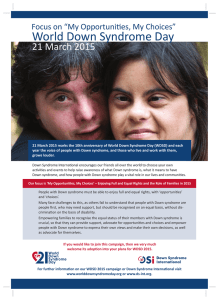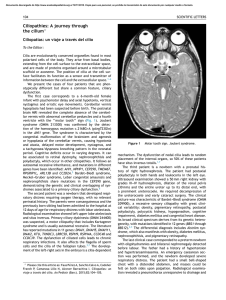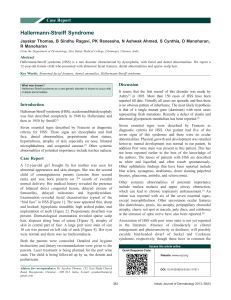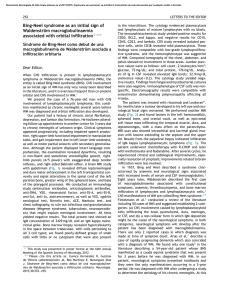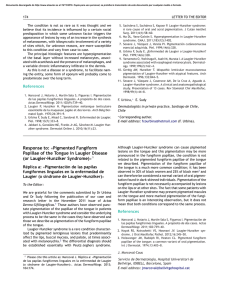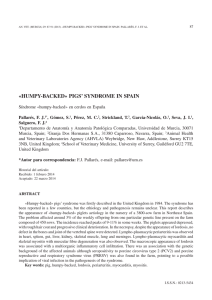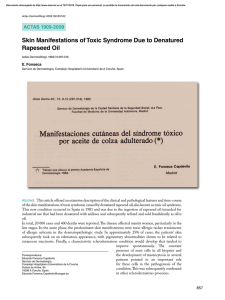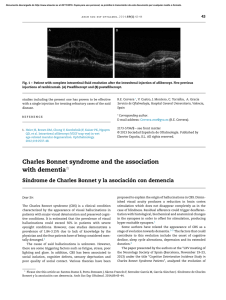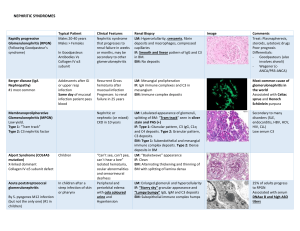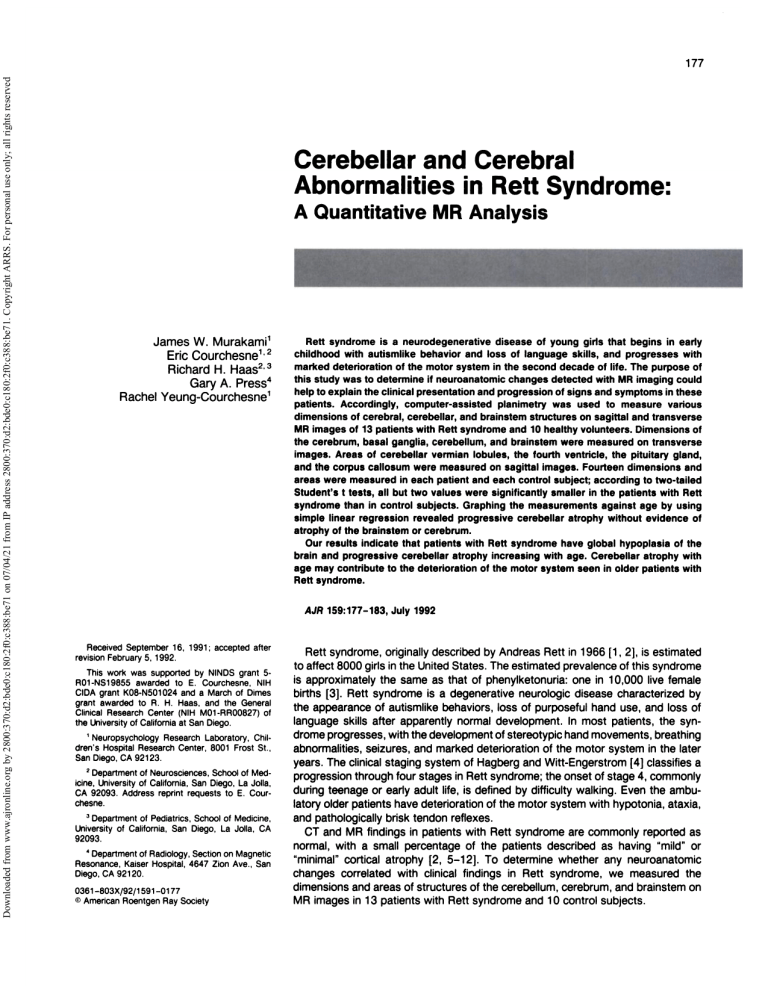
Downloaded from www.ajronline.org by 2800:370:d2:bde0:c180:2f0:c388:be71 on 07/04/21 from IP address 2800:370:d2:bde0:c180:2f0:c388:be71. Copyright ARRS. For personal use only; all rights reserved 177 Cerebellar and Cerebral Abnormalities in Rett Syndrome: A Quantitative James W. Murakami1 Eric Courchesne12 Richard H. Haas2’3 Gary A. Press4 Rachel Yeung-Courchesne1 Rett syndrome is a neurodegenerative disease of young girls that begins in early childhood with autismhike behavior and loss of language skills, and progresses with marked deterioration of the motor system in the second decade of life. The purpose of this study was to determine if neuroanatomic changes detected with MR imaging could help to explain the clinical presentation and progression of signs and symptoms in these patients. Accordingly, computer-assisted planimetry was used to measure various dimensions of cerebral, cerebellar, and brainstem structures on sagittal and transverse MR images of 13 patients with Rett syndrome and 10 healthy volunteers. Dimensions of the cerebrum, basal ganghia, cerebellum, and brainstem were measured on transverse images. Areas of cerebellar vermian lobules, the fourth ventricle, the pituitary gland, and the corpus cahlosum were measured on sagittal images. Fourteen dimensions and areas were measured in each patient and each control subject; according to two-tailed Student’s t tests, all but two values were significantly smaller in the patients with Rett syndrome than in control subjects. Graphing the measurements against age by using simple linear regression revealed progressive cerebellar atrophy without evidence of atrophy of the brainstem or cerebrum. Our results indicate that patients with Rett syndrome have global hypoplasia of the brain and progressive cerebellar atrophy increasing with age. Cerebellar atrophy with age may contribute to the deterioration of the motor system seen in older patients with Rett syndrome. AJR Received September 16, 1991; revision February 5, 1992. This work R01-NS19855 was supported awarded to CIDA grant K08-N501024 accepted after by NINDS grant 5E. Courchesne, NIH and a March of Dimes MR Analysis 159:177-183, July 1992 Rett syndrome, originally described by Andreas Rett in 1966 [1 , 2], is estimated to affect 8000 girls in the United States. The estimated prevalence of this syndrome is approximately the same as that of phenylketonunia: one in iO,000 live female births [3]. Rett syndrome is a degenerative neurologic disease characterized by grant awarded to A. H. Haas, and the General Clinical Research Center (NIH MOl -AR00827) of the University of California at San Diego. I Neuropsychology Research Laboratory, Chil- the appearance of autismhike behaviors, language skills after apparently normal drome progresses, with the development dren’s Hospital Research Center, San Diego, CA 92123. 2 Department of Neurosciences, years. The clinical staging icine, University of California, CA 92093. Address chesne. 8001 School San Diego, reprint requests 3 Department of Pediatrics, University of California, San 92093. 4 Department of Radiology, Resonance, Kaiser Hospital, Diego, CA 92120. Frost St., of MedLa Jolla, to E. Cour- School of Medicine, Diego, La Jolla, CA Section on Magnetic 4647 Zion Ave., San 0361 -803X/92/1 591-0177 © American Roentgen Ray Society abnormalities, progression seizures, through and marked system four stages loss of purposeful hand use, and loss of development. In most patients, the synof stereotypic hand movements, breathing deterioration of Hagberg of the motor system and Witt-Engerstrom in Rett syndrome; the onset in the later [4] classifies of stage a 4, commonly during teenage or early adult life, is defined by difficulty walking. Even the ambuhatory older patients have deterioration of the motor system with hypotonia, ataxia, and pathologically brisk tendon reflexes. CT and MR findings in patients with Rett syndrome are commonly reported as normal, with a small percentage of the patients described “minimal” cortical atrophy [2, 5-i 2]. To determine whether changes dimensions MR images correlated with clinical findings in Rett syndrome, as having “mild” any neuroanatomic or we measured the and areas of structures of the cerebellum, cerebrum, and bnainstem in 13 patients with Rett syndrome and 1 0 control subjects. on MURAKAMI Downloaded from www.ajronline.org by 2800:370:d2:bde0:c180:2f0:c388:be71 on 07/04/21 from IP address 2800:370:d2:bde0:c180:2f0:c388:be71. Copyright ARRS. For personal use only; all rights reserved i78 Materials and Patients Thirteen female patients with of California Rett syndrome (San Diego) were recruited from Rett Syndrome Clinic. Eleven patients had classic Aett syndrome according to the Rett Syndrome Diagnostic Criteria Work Group [1 3J. Two patients were atypical in that they had a higher level of function; nevertheless, they met most ofthe diagnostic critenafor Rett syndrome. Neither of the two atypical patients had any signs or symptoms of Rett syndrome. include apparently that would exclude the diagnosis Necessary diagnostic criteria normal prenatal and perinatal for Rett syndrome period, apparently normal psychomotor development through the first 6 months, decaleration of head growth between ages 5 months and 4 years, development of severely impaired expressive and receptive language, and stereotypic hand movements such as hand wringing or squeezing [i3J. Supportive diagnostic criteria for Rett syndrome include breath- ing dysfunction, abnormalities on electroencephalograms, spasticity, and peripheral vasomotor disturbances [13]. excluding Rett syndrome as a diagnosis include seizures, Criteria intrauterine less than the second July 1992 for percentile for eight of the Sagittal images were acquired of view of 16-24 cm after tion Ti -weighted two spin-echo with a 256 x 256 to four excitations. sequence was matrix and were were a field A sagittal multisec- used with a repetition time (TA) of 600-800 msec and an echo time (TE) of 20-25 msec. Sagittal images were obtained only after the patient was adequately positioned (verified with preliminary transverse and sagittal images) to ensure that a true midsagittal image of the brain would be obtained. The sections were 5 mm thick; consecutive slices were separated by a 2.5-mm gap. Transverse images were acquired with a 256 x 1 92 or 256 x 256 matrix and a field of view of 20-24 cm after one to two excitations. A multisection spin-echo axial sequence was used with a TA of 2000-3000 msec and TEs of 30 msec and 70-80 msec. The trans- verse images were obtained immediately after the sagittal images. The sections were 5.0 mm thick; consecutive slices were separated by a 2.5-mm gap. growth retardation, signs of storage disease, microcephaly at birth, and other identifiable metabolic or progressive neurohogic disorders [i 3]. Thirteen patients between 5 and 25 years old (i 2.0 ± 6.3 years, mean ± SD) were imaged in the transverse plane; 12 were imaged also in the sagittal plane. Rett syndrome ranged from stage 2 to stage 4. Head circumference was less than the 50th percentile for all 13 patients and AJR:i59, Electric Medical Systems, Milwaukee, WI). The control subjects imaged without sedation; the patients with Rett syndrome sedated with chloral hydrate (50-60 mg/kg body weight). Methods with Rett Syndrome the University ET AL. 1 3 patients. Eleven of i 3 patients had seizures. All patients with seizures were being treated with antiseizure medications; only four patients had been treated at some time with phenytoin. Qualitative Assessment of the Images All MR images were subjectively who reviewed Image the films with Quantification Measurements accordance assessed knowledge by a neuroradiohogist of the patients’ diagnoses. Protocol of the brain on sagittal with our previous report images [1 4]. Areas were were made calculated in by using a method of computer-assisted phanimetry in which magnified images permitted differentiation of regions of interest from surrounding structures (Fig. i All sagittal measurements were made on the ). Control Subjects midsagittal The control group consisted of and 27 years old (1 5.4 ± 7.5 years, in the transverse plane; eight were None had a history of neurologic or 1 0 female volunteers between 6 mean ± SD). All 1 0 were imaged imaged in the sagittal plane also. systemic illness. MR Imaging Protocol After images informed were consent acquired was obtained, sagittal with a 1 .5-T magnet and transverse (GE Signa, MR General image. The measurements included the area of vermian lobules l-V, vermian lobules VI-VIl, vermian lobules Vhhl-X, the fourth ventricle, the ventral pons, the corpus callosum, and the pituitary gland. The boundaries between the vermian lobules were assigned in accordance with a previous report [1 5]: the boundary between vermian lobules h-V and VI-VIl was defined as the line joining the anterior aspect of the primary fissure to the apex of the fourth ventricle; the boundary between vermian lobules VI-VIl and Vlhh-.X was defined as the line joining the anterior aspect of the prepyramidal fissure to the apex of the fourth ventricle. The fourth ventricle was designated as the area of CSF extending from the inferior aspect of Fig. 1.-A and B, Midsagittal (A) and transverse (B) MR images from a 5-year-old with Rett syndrome. Areas measured on A : cerebellar vermian lobules l-V, vI-vll, and Ul-X, fourth yentricle (4), ventral pens (P), pituitary gland (black arrow), and corpus callosum(CC). Width of basal ganglia (open arrows) and lateral width of corebrum (white arrows) at level of basal ganglia were measured on B. Downloaded from www.ajronline.org by 2800:370:d2:bde0:c180:2f0:c388:be71 on 07/04/21 from IP address 2800:370:d2:bde0:c180:2f0:c388:be71. Copyright ARRS. For personal use only; all rights reserved AJA:159,JuIy MR OF RETT SYNDROME 1992 the quadrigeminal plate to the obex, bounded posterior aspect of the brainstem and posteriorly anteriorly by the by the medullary velum, cerebellar vermis, and cerebellar tonsils. The area of the ventral pons is bounded anteriorly by CSF and posteriorly by the ventral aspect of the medial lemniscus, as described by Carpenter [1 6J, Hayakawa et al. [i 7J, and Hsu et al. [1 8]. The areas of the pituitary gland and the corpus callosum (measured from rostrum control Midsagittal subjects observers measurements correlated were measurements data presented in good (r well = agreement All quantitative of the cerebrum width, as described transverse dimension The widths bisecting olives were the brainstem the brainstem determined The cerebellar by choosing halves, the and measuring the distance from the midline to the lateral aspect of the brainstem through the left and night inferior olives. The anteropostenor length of the brain was the greatest anteropostenior dimension of the cerebrum shown on a single transverse image. The lateral width of the basal ganglia was determined by first choosing the transverse slice that best showed the putamen and globus palhidus and then measuring the distance perpendicular to the midline of the brain from the lateral aspect of the putamen of one hemisphere to the lateral aspect This “basal ganghia” line begins at the lateral aspect of one putamen, passes sequentially through that putamen, the corresponding globus pallidus, the midline of the brain adjacent to the mamillothalamic tracts, the globus pallidus of the opposite hemisphere, and finally the putamen of the opposite hemisphere (Fig. 1). By dividing the width of the basal ganglia by the cerebral width, we created ratio of basal ganghia width to brain width. Transverse measurements were made by a single observer who knew the groups’ designations. a As cachexia is common in older patients with Rett syndrome, we correlated our brain measurements with several body measurements (height, weight, head circumference) in the patients with Aett syndrome. Statistical analysis of the data (statistical significance was p analyses (statistical significance included two-tailed .05) and simple was p .01). Student’s t tests linear regression Results Subjective with volumes (Fig. and pituitary cerebellar inferior and pituitary olives, vermian gland.-Measunements of cenlobules l-V, fourth ventricle, gland were all significantly smaller (by i 3-45%) in the patients with Rett syndrome than in the control subjects (see statistical results in Table 1). Measurements of the areas of the ventral pons and vermian lobules gland. Conversely, changes structures with increasing age the patients reduction with Rett syndrome showed a statistically significant in the area of vermian lobules I-V, VI-VIl, and VIIIx (for each area; n = 1 2, r .738, p .005) and a trend toward enlargement in the area of the fourth ventricle (n = i i , r = .665, p = .024). For example, the area (mean ± SD) of vermian lobules VI-VIl in the younger patients with Rett syndrome (5-iO years old, n = 8) was 265.5 ± 38.1 mm2 whereas in the older patients with Rett syndrome (i 3-25 years old, n = 4) this area was 188.2 ± 46.3 mm2. The ventral pons, inferior olives, changes and and pituitary gland had no significant in the patients with Rett syndrome. basal gang/ia-Quantitative analyses showed that measurements of cerebral width and length, basal ganghia width, and corpus callosum area were all significanthy smaller(by i 0-27%) in the patients with Rett syndrome than in the control The widths subjects (see statistical results of the basal ganghia and cerebrum in Table 1). were similarly reduced in the patients with Rett syndrome (see basal ganghia ratio in Table 1). No significant age-related changes were found in any measurement of supratentonial structures in either the Rett or the normal group. Anthropometric data.-No statistically significant (p .Oi) linear correlations were found between any of the measurements of the posterior fossa, pituitary gland, and supratentonal structures made on MR images and any of the anthropometnic measurements (height, weight, head circumference). Discussion Assessment Nearly all measurements The MR data for the patients qualitatively fossa ebellan width, age-related Cerebrum of the putamen of the opposite hemisphere, with the measurement line crossing the midline adjacent to the mamillothalamic tracts (Fig. i). a 23-year-old Measurements and the pituitary at the level of the inferior olivary into lateral and and hemispheric cant. In the control group, no significant age-related were found in measurements of posterior fossa in a previous report [i4], was the greatest of the cerebellum shown on a transverse image. of the inferior image that showed nuclei, at the level of the basal ganglia. Objective volume vermian VI-VIl and VIII-X also were smaller in the patients with Rett syndrome, but these differences were not statistically signifi- Measurements made on transverse images included the cerebellar width, the widths of the inferior olives, the anteroposterior dimension of the cerebrum, the lateral width of the basal ganglia, and the lateral width vermian decreased Posterior of the two observers for the .923-994). Likewise, the two (r = .956-991 ) on all seven in the patients with Rett syndrome. here are from one observer. decreased severely 3). to splenium) were measured by using a previously described method [i 7]. Sagittal measurements were made independently by two observers. The observers were not blinded to the subjects’ group designations. mildly i79 assessed with Rett syndrome by a neuroradiologist who knew were the patients’ diagnoses when viewing the films. His impressions of the MR images from the 13 patients with Rett syndrome were (i) normal findings in eight cases (Fig. 2); (2) decreased cerebral volume, primarily in the frontal lobe, in three patients 6, i 2, and 14 years old but not in any of the older patients; and (3) decreased cerebellan volume without cerebral abnormahity in the two oldest patients, but not in any of the younger patients. The two oldest patients were a 25-year-old with of length and area of the cerebel- hum, brainstem, basal ganglia, and cerebrum smaller than normal in our 5- to 25-year-old syndrome neural (Table i). This evidence structures are similarly were significantly patients with Rett suggests affected that a variety of and that Rett syn- drome may involve widespread brain hypophasia. In addition, the area of the cenebellan vermis decreased with age and the area of the fourth ventricle increased with age. These findings indicate a progressive loss (i.e., atrophy) of the cenebellar parenchyma with age; measurement of other brain regions did not show age-related loss. Unlike the finding of widespread MURAKAMI Downloaded from www.ajronline.org by 2800:370:d2:bde0:c180:2f0:c388:be71 on 07/04/21 from IP address 2800:370:d2:bde0:c180:2f0:c388:be71. Copyright ARRS. For personal use only; all rights reserved i80 ET AL. AJR:159, July 1992 Fig. 2.-A-D, Midsagittal and transverse MR images from an 8-year-old patient with Rett syndrome (A and B) and a 6-year-old control subject (C and D) show no qualitative differences, but quantitative differences exist (Table 1). A B F-:-- hypoplasia, in the hatter Rett syndrome Cerebellar results and Brainstem MR imaging suggest may be localized indicated that significant atrophy to the posterior fossa. Findings that two processes seem to affect the cerebellum in Rett syndrome: hypophasia and late-onset atrophy. On MR images, hypoplasia (undergrowth) was evidenced by the significantly reduced width of the cerebellan hemispheres and reduced midsagittal area of the anterior vermis; the posterior venmis also was insignificantly smaller. These size reductions appeared in young patients who had no sign of atrophy (e.g., no increased sulcal widening) and in older patients. These quantitative MR findings are consistent with those of qualitative autopsy reported that the cerebellum year-old patients studies: appeared with Rett syndrome, Ohdfors et al. [19] small in their 7- to 30and Bauman and Kem- per [20] reported increased cell packing density (a sign of arrested development) in the cerebellum in one 12-year-old patient. In the youngest of the autopsy cases in the study by Ohdfors et al., no atrophy of the cerebellum was visible on macroscopic examination. In the olden patients with Rett syndrome but not in the younger ones, atrophy (evidenced by large increases in sulcal width) was shown on MR images of the cerebellar venmis and hemispheres (Fig. 3). Measurement of the venmis and fourth ventricle confirmed the presence of an age-related decline in the size of the cerebellum. These MR results parallel the autopsy data of Oldfors et al. [i 9], who reported macroscopic evidence tients cases molecular, matter, of cenebellar with Rett atrophy syndrome. with the most Purkinje, accompanied in older but not younger Autopsy severe atrophy, data indicate that pain the ghiosis was found in and granular layers and in the white by loss of neurons in the molecular and Downloaded from www.ajronline.org by 2800:370:d2:bde0:c180:2f0:c388:be71 on 07/04/21 from IP address 2800:370:d2:bde0:c180:2f0:c388:be71. Copyright ARRS. For personal use only; all rights reserved AJR:159, MR OF RETT July 1992 i8i SYNDROME Fig. 3.-A-F, Representative sagittal MR images from a 9-year-old (A-C) and a 23-year-old (0-F) with Rett syndrome. In older patient, vermian and hemispheric fissures are markedly widened (thought to represent cerebellar atrophy); arrowheads point to several such widened and D are midsagittal images, B and E are 7.5 mm lateral to midsagittal, and C and F are 15 mm lateral to midsagittal. Purkinje cell layers Kemper [20] did not report year-old patient. apparently and in the dentate Thus, begins in nucleus. loss of neurons in Rett childhood Bauman and in their one i 2- syndrome, loss or adolescence of neurons and pro- gnesses for many years. The cenebellar atrophy found in Rett syndrome may be an integral part of the disorder and would be consistent with the degeneration of the motor system with stage 3-4 Rett syndrome. to the poor nutritional status seven of our 13 patients weight). However, seen clinically in patients Alternatively, it may be related typical of these patients (e.g., were less than the fifth percentile in the patients no significant (p with Rett syndrome for in the present study, .Oi ) correlations between height, weight, and head circumference and cerebellar measurements were found. This does not rule out poor nutrition as a contributing factor in the cerebellar atrophy, but this factor seems less likely to be one of the more important factors. The cerebellan neuronal loss and ghiosis and attendant atrophy might instead be related to the presence of seizure disorders, which is also typical of patients with Rett syndrome (e.g., seen in 1 i of our i3 patients) or to the use of anticon- vulsant medications (1 i of our i 3 patients convulsants; four have received phenytoin). cenebellar atrophy warrants further study. These characteristics of cerebellar cerebellar fissures. A have taken antiThis age-related abnormalities distinguish Rett syndrome from several other developmental disorders involving the cerebellum, such as infantile autism, fragile X syndrome, and Down’s syndrome. For example, in infantile autism, hypoplasia occurs but later atrophy does not; hypephasia is limited to posterior vermis and hemispheres (including the flocculonodular lobe) and does not involve the anterior vermis; loss of Purkinje neurons is prenatal or perinatal, not hate in childhood or adolescence; no cerebellar cortical ghiosis or gliosis and loss of myehin in white matter occurs; and no loss of neurons in the dentate nucleus occurs [21 , 22]. Thus, although patients with early stages of Rett syndrome have some of the behavioral features of classic infantile autism, the radiologically and microscopically observed spectra of cenebellar involvement in these two groups of patients differ markedly. As another bellan hypoplasia childhood and example, without adolescence; in Down’s progressive granule syndrome, atrophy cell is seen dysgenesis cereduring occurs MURAKAMI Downloaded from www.ajronline.org by 2800:370:d2:bde0:c180:2f0:c388:be71 on 07/04/21 from IP address 2800:370:d2:bde0:c180:2f0:c388:be71. Copyright ARRS. For personal use only; all rights reserved 182 TABLE 1: Quantitative Rett Syndrome Measurements ET AL. on MR Images AJR:159, in Control Subjects and in Patients July 1992 with % Size Reduction Control Subjects Measurement Patients with Rett Syndrome in Patients Value with Rett Syndrome Posterior fossa Venmis I-V (mm2) Vermis VI-VIl (mm2) Vermis VlIl-X (mm2) 393.9 276.5 ± 36.4 (8) ± 53.1 (8) 287.9 ± 43.0 (6) i0i.0 ± 3.1 (iO) i78.6 ± 59.4 (8) 325.2 ± 35.1 (8) Cerebehlar width (mm) Fourth ventricle (mm) Ventral pons (mm2) Inferior olive width (right) (mm) 7.8 Inferior olive width (heft) (mm) Supratentorium Cerebral anteroposterior length 343.1 239.8 24i.4 89.6 122.1 294.0 0.9 (8) ± ± ± ± ± ± ± 51.4 54.4 68.9 6.4 30.7 32.8 ± 0.8 (1 3) 17 .003 6.6 ± 0.6 (1 3) 13 .012 6.5 7.6 ± 0.8 (8) (12) (1 2) (ii) (13) (1 1) (i2) 13 i 3 16 12 31 10 .027 .152 .157 <.001 .034 .058 1 63.6 ± 5.0 (9) 1 44.8 ± 7.0 (1 3) 12 <.OOi 1 16.6 589.9 1 03.0 430.9 54.6 0.53 25.5 ± ± ± ± ± 11 27 10 <.OOi .002 <.001 .286 .012 (mm) Cerebral lateral width (mm) Corpus callosum (mm2) Basal ganglia width Basal ganglia ratio Pituitarygland(mm2) (mm) ± 6.4 (8) ± 93.5 (8) 60.7 ± 2.5 (8) 0.52 ± 0.02 (8) 46.2 ± 17.6(8) 6.0 (1 3) 102.6 (12) 3.0 (13) 0.02 (13) 5.1 (10) 45 Note-Measurements are presented as mean ± SD, followed in parentheses by the number of subjects. The p values were calculated from pooled variances when Levene’s F-test showed variances to be insignificantly different (p .1) and from separate variances when variances were shown to be significantly different (p .1). but not dysgenesis or later loss of Purkinje cells. As a last example, in fragile X syndrome the posterior vermis is reduced in size but the anterior vermis is not [23]. Measurements of the transverse width of the cerebellar hemispheres and measurements of brainstem structures interconnected with the cerebellum (ventral pens and inferior olives) did not closely reflect the amount of cerebellar atrophy seen in the patients with Rett syndrome. A lack of such correlations has been noted in other disorders. For example, in a patient even though reduced with progressive the vermis in size by 85% cerebellar and cerebellar and 42%, degeneration [24], hemispheres were respectively, the width the cerebellum, the widths of the inferior olives, midsagittal area of the ventral pons were reduced 4%, 2%, and i 3%, respectively. Supratentorial of and the by only Findings MR imaging showed clean evidence of hypoplasia of the cerebrum and the basal ganglia in Rett syndrome but no evidence of atrophy. For instance, cerebral length and width and measurements of the corpus callosum were reduced 10- 27%, but no evidence head circumference is usually normal at birth, but its growth rate decelerates after the age of 5-6 months [26, 27]. This deceleration occurs in the midst of a rapid and critical phase of human postnatal brain growth: for instance, from birth to 2 years, the number of synapses in the cerebrum nearly doubles [28], and the weight of the human brain normally more than doubles, from 384 to 96i g (see Table i i i in Bhinkov and Glazer [29]) [30]. The rate of growth thereafter is significantly shower, but growth continues into the third decade of life [29]. Autopsy evidence is also consistent with MR evidence of cerebral hypoplasia and arrest of development without significant age-related global atrophy in patients with Rett syndrome. For example, recent autopsy findings in a i 2-year-old patient with Rett syndrome [20] included signs of developmental arrest such as increased cell packing density throughout the cerebral cortex, basal ganghia, thalamus, hippocampus, amygdaha, and cerebellum. In addition, the mean weight of the brain in 1 4 6- to 30-year-old patients with Rett syn- drome from three studies [i 9, 20, 3i] is 945 g, a weight comparable to the normal weight in 2-yean-olds smaller than the normal weight in 6- to 30-year-old and 26% females widening was found. In a recent MR report, Casanova et al. [25] also found the cerebral hemispheres and caudate nuclei [29, Table i i i]. Moreover, the mean brain weight of the three youngest patients reported in the literature (6, 7, and 8 years old [i9, 3i]) differs by only 4% from the brain weight of the in patients three with Rett of abnormal syndrome signal intensities to be smaller than or sulcal those in control subjects. However, they did not find a difference in a measurement of the corpus callosum, perhaps because their control subjects were patients rather than healthy volunteers. These abnormal measurements of the cerebrum and basal ganghia from MR images are consistent with the microcephaly seen in other studies of Rett syndrome [2, 5, 6, 1 0-i 2] and in most of our patients. In patients with Rett syndrome the oldest old [1 9, 3i]). youngest patients in the literature Additionally, Rett cases (i 8, 20, and the mean brain weight reported in the autopsy 30 years of the eight literature (6-i 2 years old) is only slightly smaller than that of the six oldest cases (i 3-30 years old) (920 vs 978 g) [1 9, 31]. It is uncertain if atrophy of the cerebral cortex occurs in Rett syndrome. Some autopsy and imaging studies of the brain have stated that in a minority of patients with Rett Downloaded from www.ajronline.org by 2800:370:d2:bde0:c180:2f0:c388:be71 on 07/04/21 from IP address 2800:370:d2:bde0:c180:2f0:c388:be71. Copyright ARRS. For personal use only; all rights reserved AJA:159,July syndrome, [2, 5-7, MR OF RETT 1992 the cerebral 9-i 2, 3i]. cortex show signs of “slight” Unfortunately, these studies atrophy generally failed to maintain a clinically meaningful distinction between hypoplasia, defined as incomplete development or underdevelopment, and atrophy, defined as a wasting away, loss, or dimunition of previously developmental established disorders, of some parenchymal hypoplasia element brain parenchyma. In can result from atrophy (e.g., during early development, previously established Purkinje neurons may die, which then leads to cerebellan hypoplasia, as in infantile autism). None of the brain imaging or autopsy studies that did report atrophy in Rett syndrome provided the evidence necessary to draw this conclusion. On the contrary, the weight of evidence leans toward hypoplasia (e.g., arnest of brain weight, increased cell packing density, no age-related increase in sulcal width, no age-related changes in cerebral width or length, mild to absent evidence of cortical or white matter ghiosis in the cerebrum) Ii 9, 29, 3i , this study]. The abnormality of the basal ganghia detected with MR imaging [25, this study] and at autopsy in patients with Rett syndrome is compatible with other indexes of dysfunction of the basal ganglia in this disorder. For example, patients with Rett syndrome have dysfunction of the extrapyramidal motor system, including abnormal hand-wringing behavior, gait apraxia, and truncal ataxia [4, 32]. Moreover, positron emission tomography showed evidence of decreased D2-dopa- mine receptor binding in the caudate nucleus of a 25-year-old patient with Rett syndrome [33]. Finally, “isolated abnormal neunites and reactive been seen at autopsy Rett syndrome or degenerative in the caudate axonal nucleus swellings” of patients have with [3i]. A final implication clinical neuroradiologic of the present examination study has to do with the of neurohogically or de- velopmentahhy impaired patients. Findings on neunoimaging studies of patients with Rett syndrome are commonly interpreted as normal [6-9]. A neunonadiologist interpreted quahitative findings on MR images as normal in eight of our patients with Rett syndrome. However, the quick, accurate, and simple quantitative analyses used in this study revealed that these normal images were markedly abnormal in all supratentorial and posterior fossa regions measured. Quantitative analyses are an important complement to routine radiologic interpretation of neunoimaging studies, particularly in children. ACKNOWLEDGMENT We thank Jeanne Townsend for assistance with the statistical analyses. REFERENCES 1 . Aett A. Uber em eigenartiges himatrophisches Syndrom bei Hyperammoniamie in Kindesalter. Wien Med Wochenschr 1966;1 16:723-738 2. Rett A. Cerebral atrophy associated with hyperammonemia. In: Vinken PJ, Bruyn GW, eds. Handbook of clinical neurology, vol. 29. Amsterdam: North-Holland, 1977:305-329 3. Trevathan E, Adams MJ. The epidemiology and public health significance of Aett syndrome. J Child Neurol 1988;3[suppll:S17-S20 4. Hagberg B, Witt-Engerstrom I. Aett syndrome: a suggested staging system SYNDROME i83 for describing impairment profile with increasing age towards adolescence. Am J Med Genet 1986;24:47-59 5. Hagberg B, Aicardi J, Dias K, Ramos 0. A progressive syndrome of autism, dementia, ataxia, and loss of purposeful hand use in girls: Rett syndrome. Report of 35 cases. Ann Neurol 1983;14:471-479 6. Naidu 5, Murphy M, Moser HW, Aett A. Aeft syndrome: natural history in 70 cases. Am J Med Genet 1986;24:61 -72 7. Wu X, Zhao D, Ling 0, et al. Rett syndrome in China: report of 9 patients. Pediatr Neurol 1988;4: 126-1 27 8. Burd L, Gascon G, Kerbeshian J. Rett syndrome: case reports and management strategies. Neurosci Biobehav Rev 1988;12:283-287 9. Krageloh-Mann I, Schroth G, Niernann G, Michaelis A. The Rett syndrome: magnetic resonance imaging and clinical findings in four girls. Brain 0ev 1989;11 : 175-1 78 1 0. Suzuki H, Matsazuka T, Hirayama Y, et al. Rett’s syndrome: progression of symptoms from infancy to childhood. J Child Neurol 1986;1 : 137-1 41 1 1 . Nomura Y, Segawa M, Hasegawa M. Aett syndrome: clinical studies and pathophysiological oonsideration. Brain 0ev 1984;6:475-486 1 2. Moeschler JB, Charman CE, Berg SZ, Graham JM Jr. Rett syndrome: natural history and management. Pediatrics 1988;82: 1-10 1 3. The Rett syndrome Diagnostic Criteria Work Group (Trevathan E., Chairman). Diagnostic criteria for Rett syndrome. Ann Neurol 1988;23:425-428 14. Murakami JW, Courchesne E, Press GA, et al. Reduced cerebellar hemisphere size and its relationship to vermal hypoplasia in autism. Arch Neurol 1989:46:689-694 15. Courchesne E, Yeung-Courchesne A, Press GA, et al. Hypoplasia of cerebellar vermal lobules VI and VII in autism. N EngI J Med 1988; 318: 1349-1 354 1 6. Carpenter MB. Human neuroanatomy. Baltimore: Williams & Wilkins, 1976: 322-325 1 7. Hayakawa K, Konishi Y, Matsuda T, et al. Development and aging of brain midline structures: assessment with MA imaging. Radiology 1989;172:171-177 1 8. Hsu M, Yeung-Courchesne A, Courchesne E, Press GA. Absence of pontine abnormality in infantile autism. Arch Neurol 1991;48: 1160-1163 19. Oldfors A, Sourander P, Armstrong DL, et al. Aett syndrome: cerebellar pathology. Pediatr Neurol 1990;6:310-314 20. Bauman ML, Kemper TL. The neuropathology of Rett syndrome is pervasive throughout the brain. Neurology 1991;41 :306-308 21 . Ann DM, Bauman ML, Kemper TL. The distribution of Purkinje cell loss in the cerebellum in autism. Neurology 1991;42:307 22. Bauman ML. Microscopic neuroanatomic abnormalities in autism. Pediatrics 1991:87:791-796 23. Aeiss AL, Patel 5, Kumar AJ, Freund L. Preliminary communication: neuroanatomical variations of the posterior fossa in men with the fragile-X (Martin-Bell) syndrome. Am J Med Genet 1988:31:407-414 24. Akshoomoff cerebellum NA, Courchesne to neuropsychological E, Press G, Iraqui V. Contribution functioning: evidence from of the a case of cerebellar Casanova degeneration. Neuropsychologia 1991 (in press) 25. MF, Naidu 5, Goldberg TE, et al. Quantitative magnetic resonance imaging in Aett syndrome. J Neuropsych Clin Neurosci (in press) 26. Trevathan E, Naidu S. The clinical recognition and differential diagnosis of Aett syndrome. J Child Neurol 1988;3[suppl]:S6-S16 27. Burd L, Gascon G. Rett syndrome: review and discussion of current diagnostic criteria. J Child Neurol 1988:3:263-268 28. Huttenlocher PR. Morphometnc study of human cerebral cortex developmont. Neuropsychologia 1990:28:517-527 29. Blinkov SM, Glezer II; Haigh B, trans. Weight, volume, and linear dimensions of the brain. In: The human brain in figures and tables: a quantitative handbook. New York: Basic Books and Plenum, 1968:123-136 30. Dobbing J, Sands J. Quantitative growth and development of human brain. Arch Dis Child 1973:48:757-767 31 . Jellinger K, Armstrong D, Zoghbi HY, Percy AK. Neuropathology of Aett syndrome. Acta Neuropathol 1988:76:142-158 32. Hagberg B. Aett syndrome: clinical peculiarities, 33. diagnostic approach, and possible causes. Pediatr Neurol 1989;5 :75-83 Hams JC, Wong DF, Wagner HN, et al. Positron emission tomography study of D2 dopamine receptor binding and CSF biogenic amine metabolites in Rett syndrome. Am J Med Genet 1986:24:201-210
